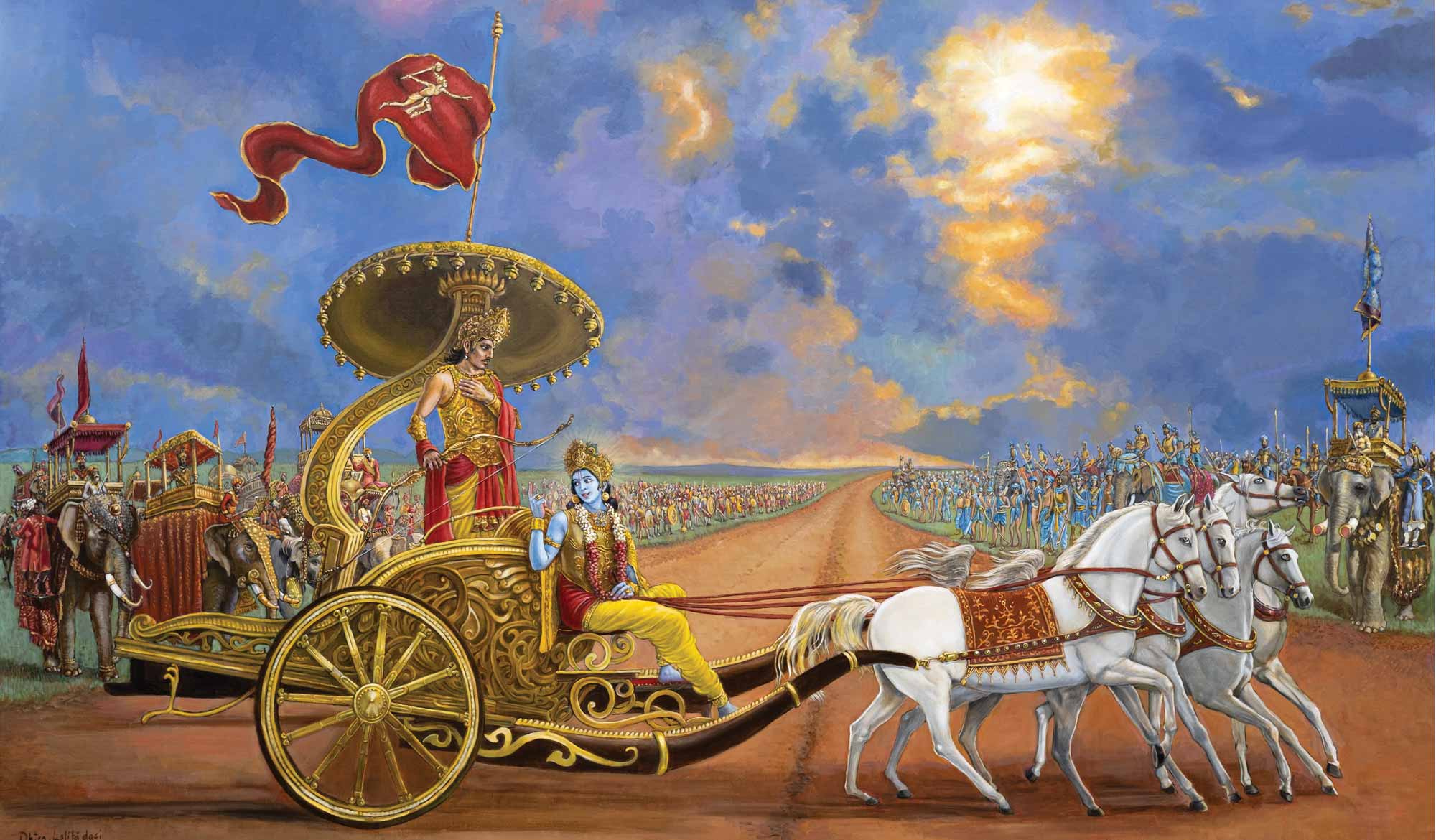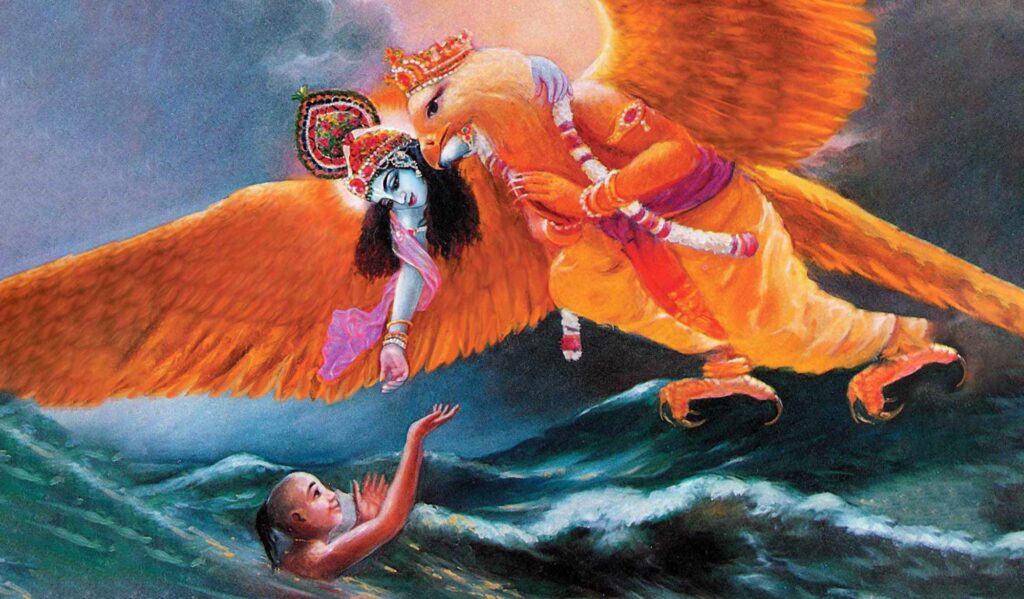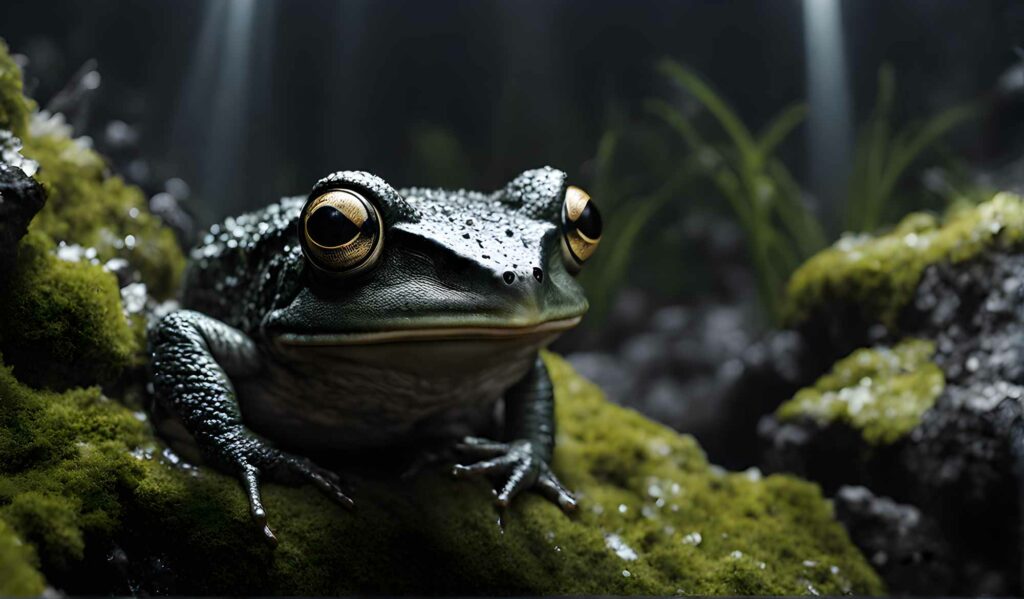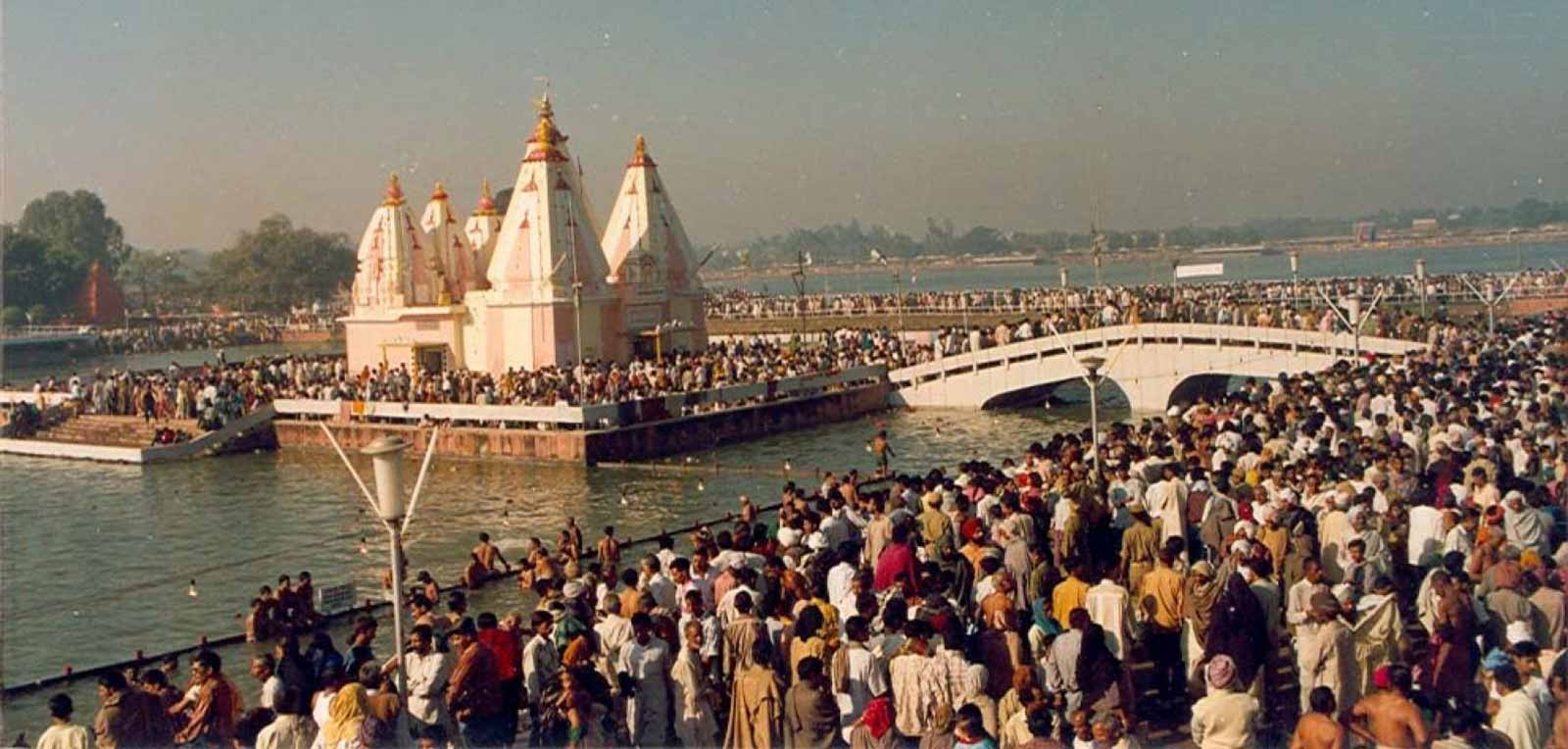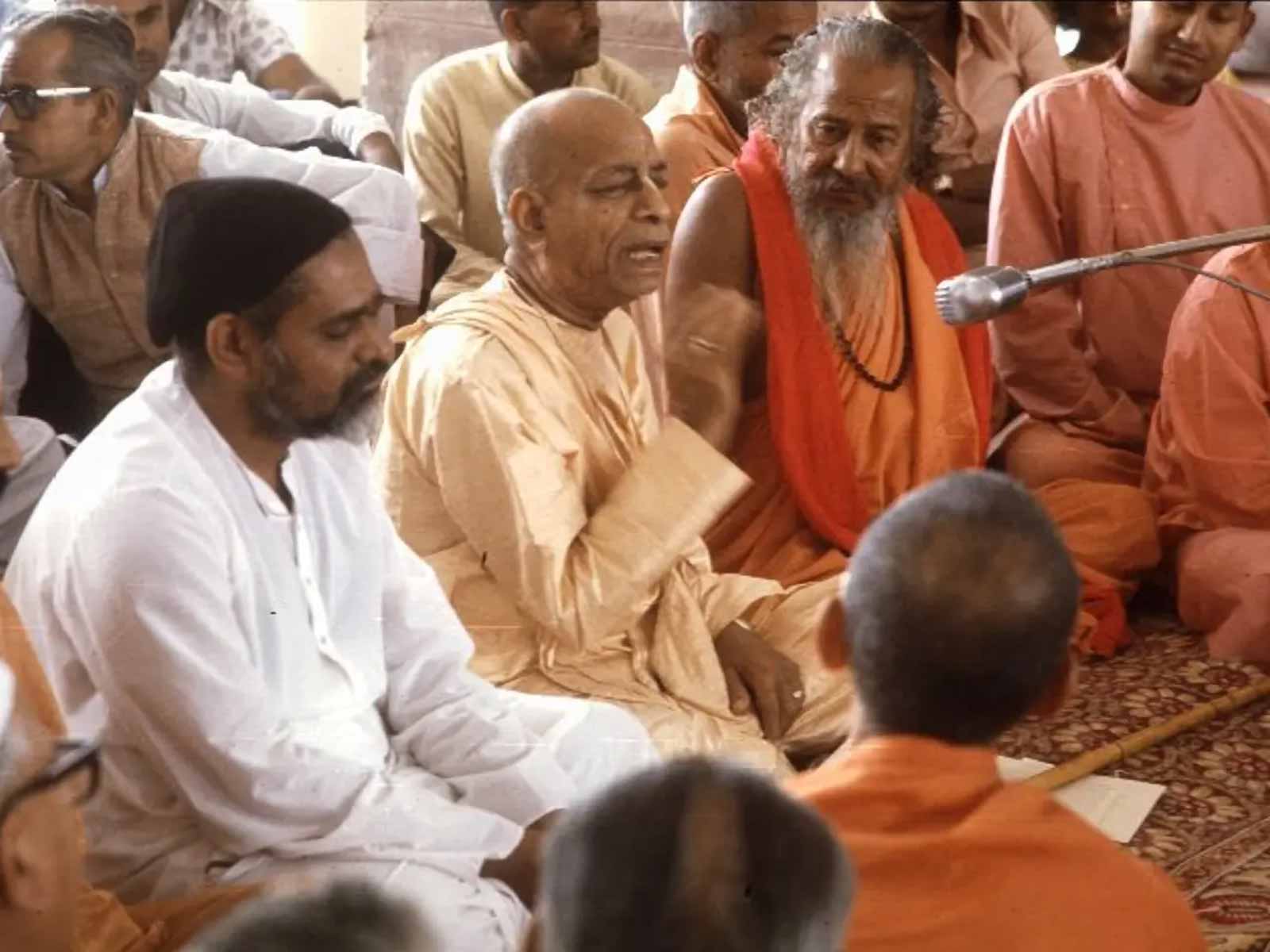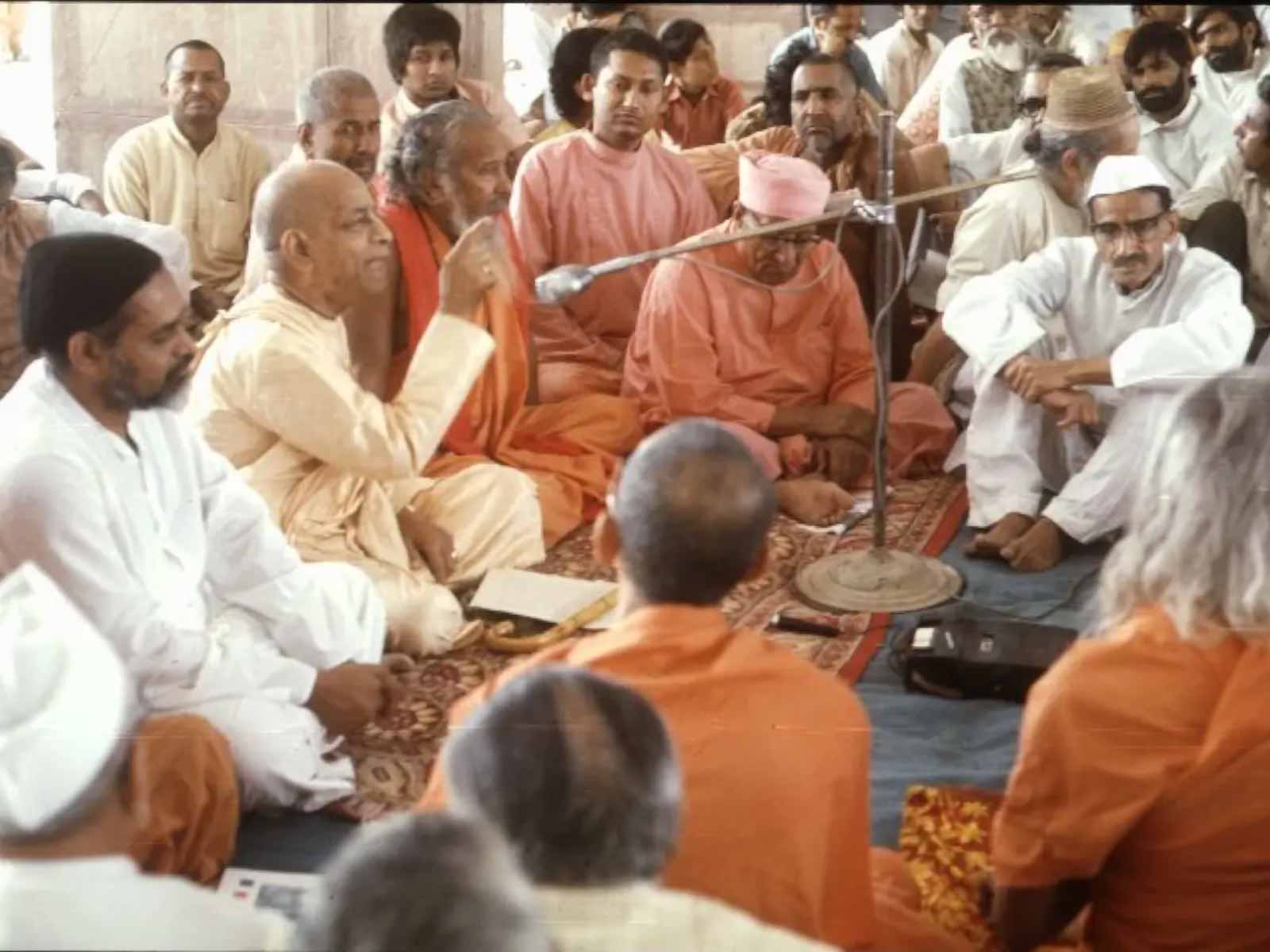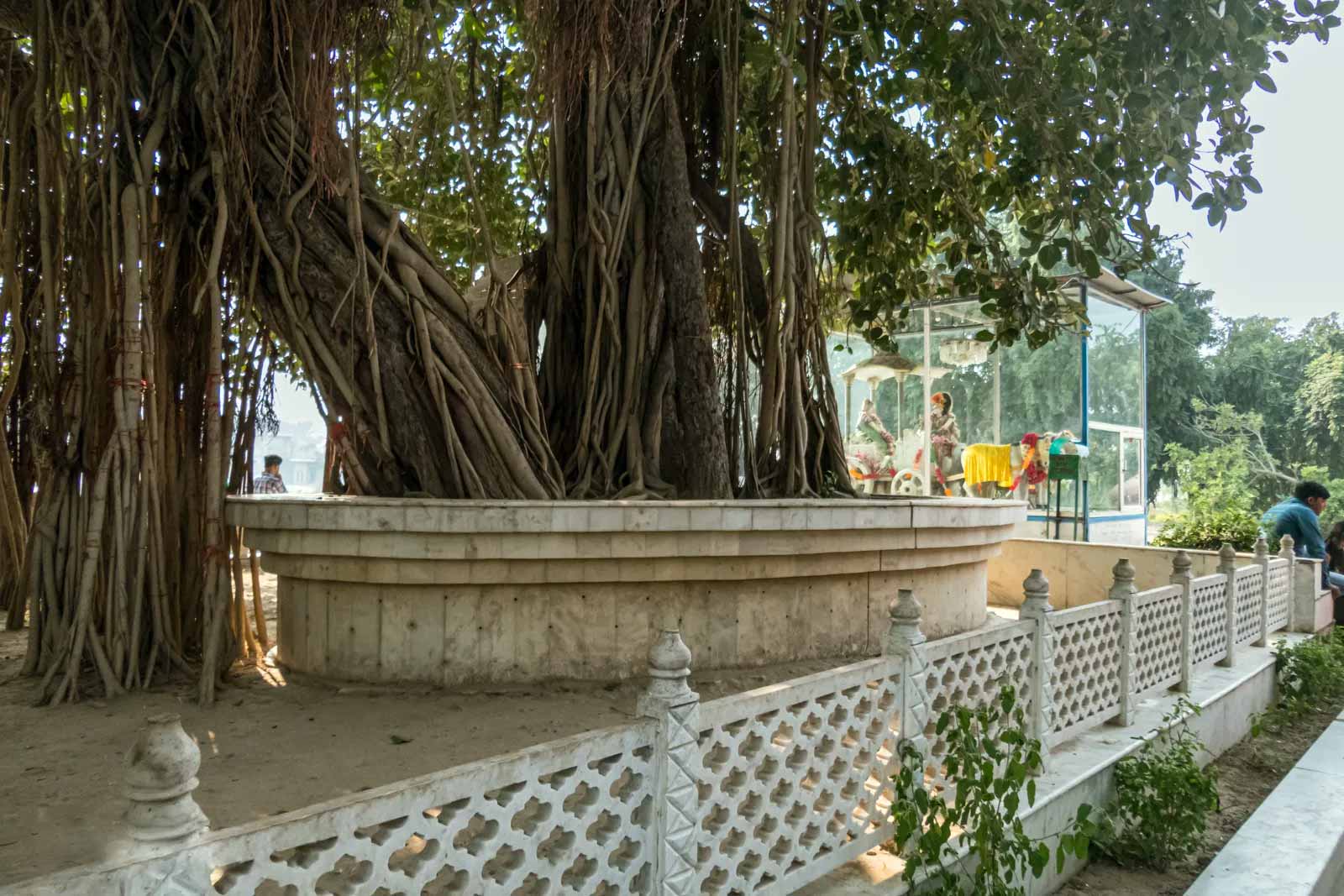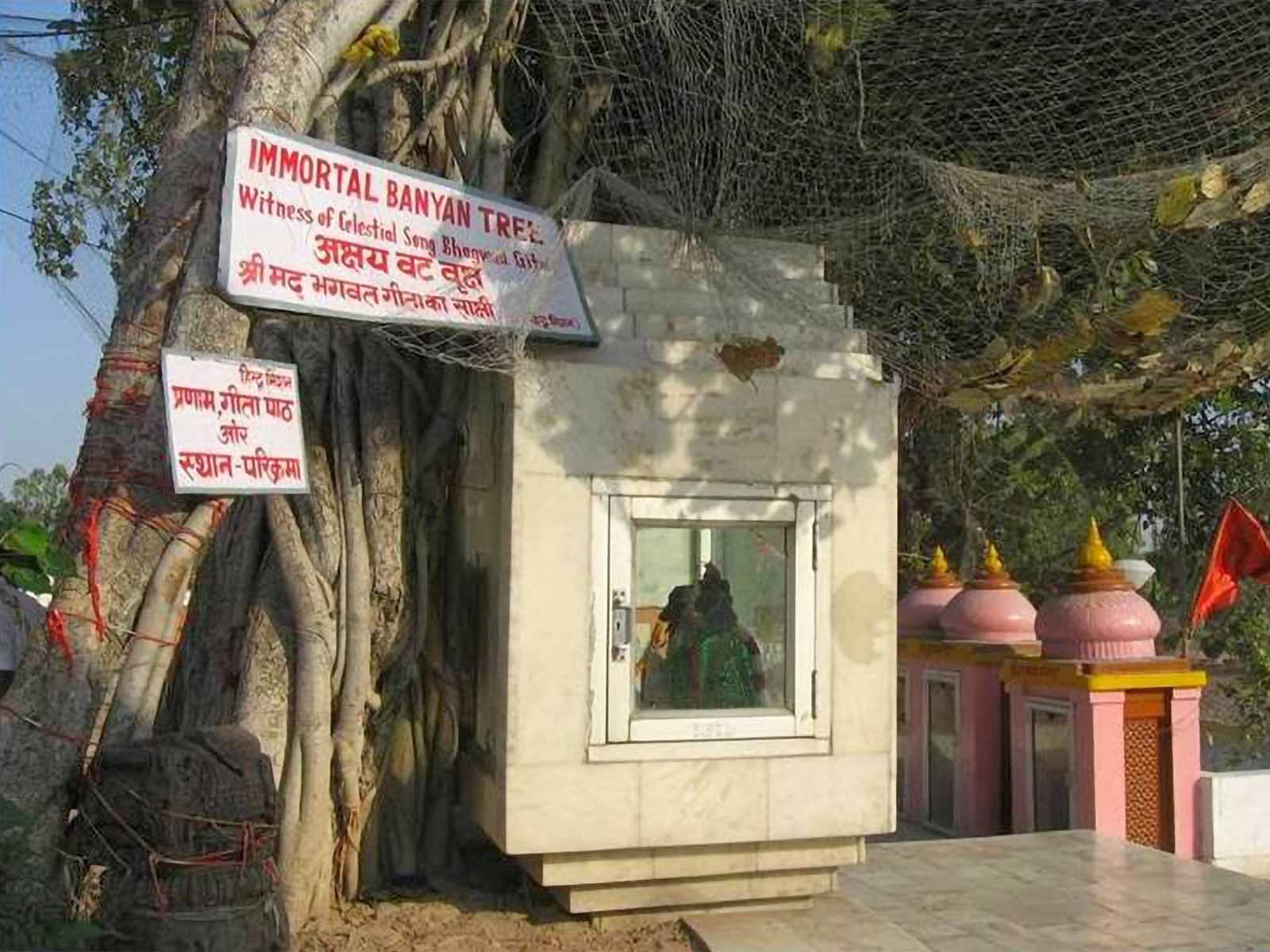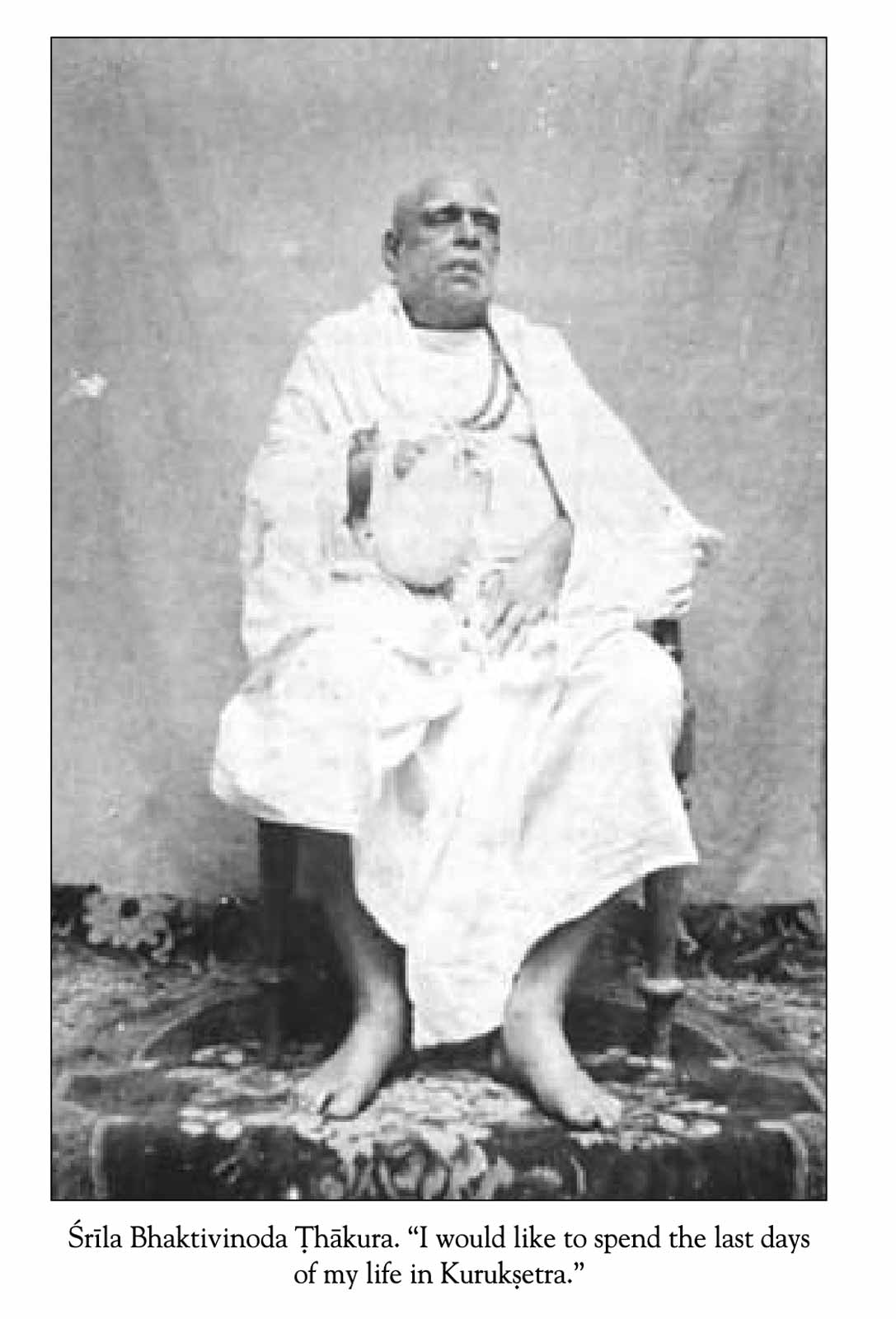Overview
Continuing with our pilgrimage series, in time for this week’s Gītā Jayantī celebrations, Śrīla Narasiṅgha Mahārāja discusses the sacred land of Kurukṣetra where Śrīmad Bhagavad-gītā was spoken and explains it’s deeper significance. This article was adapted from a number of talks given by Mahārāja, one at Kurukṣetra in 1990 as well as later talks in Vṛndāvana and Mexico.
Kurukṣetra is, of course, famous as the place where Lord Kṛṣṇa spoke Bhagavad–gītā to His devotee, Arjuna. But even before the Gītā was spoken, Kurukṣetra was famous in the Purāṇas as a holy place. In Kṛṣṇa Book, Śrīla Prabhupāda says that Paraśurāma came to Kurukṣetra to purify himself after he had killed all the kṣatriyas. Of course, being an incarnation of Kṛṣṇa, Paraśurāma doesn’t need to be purified, but to set an example and to show the greatness of Kurukṣetra, he came there and performed some tapasya, some atonement, and did some sacrifices. That was in Treta-yuga.
Then at the end of Dvāpara-yuga, Kurukṣetra was the place chosen for the battle between the Pāṇḍavas and the Kauravas. In his commentary to the first verse of Bhagavad-gītā, Prabhupāda explains that Kurukṣetra was an ancient holy place in India and the Pāṇḍavas were devotees and followed the path of dharma, so Dhṛtarāṣṭra, the father of the Kauravas, felt that such a holy place might affect the outcome of the battle. His sons, led by Duryodhana, were the exact opposite – they were followers of adharma, or irreligion, so naturally he was worried.
(Kurukṣetra in Haryana, India)
There are three reasons why Kṛṣṇa spoke the Bhagavad-gītā. Firstly, Kṛṣṇa spoke the Gītā on the first day of the battle, just before it began. All the armies of the known world assembled for this great battle. Such a big event is about to happen, everybody who is anybody at that time was looking and, as I always say, Kṛṣṇa stood there and said, “Well, now that I have your attention…” Secondly, Kṛṣṇa spoke for the benefit for all the conditioned souls in this world, and thirdly, and most importantly, Kṛṣṇa created the whole Kurukṣetra scenario just to show how He favours His devotees. “Let it be known that I favour My devotees, and to show this, I am going to take out millions of people!” Only a handful of people walked off the battlefield, including the Pāṇḍavas. It was just a drama.
The whole Gītā is a conversation within a conversation – it was Sañjaya, the servant of Dhṛtarāṣṭṛa, telling him about the conversation between Kṛṣṇa and Arjuna. Sañjaya and Dhṛtarāṣṭra were about three-hundred kilometres away in Hastinapura, which is modern day Delhi. There were no TVs, cameras, computers and such inventions five-thousand years ago, so how did Sañjaya know what was happening in real time? Sañjaya was a disciple of Vyāsadeva and had been blessed with divine vision, divya-cakṣu, that he would be able to view the goings on at Kurukṣetra over the eighteen days of the battle so he could relate that to Dhṛtarāṣṭra.
In one place, Śrīla Prabhupāda says that about 6 million 400 thousand soldiers died in the war, and in some places in śāstra, perhaps in Mahābhārata, it says 4 million. Whatever the case, there were a lot of soldiers there at Kurukṣetra. Now one question is there – if so many people died at Kurukṣetra, where is the archaeological evidence? Well, they have found a few things at Kurukṣetra such as arrowheads and small things like that, but the problem with archaeology in places like Kurukṣetra and Benares is that these places tend to get lived on over the centuries by many generations, and towns grow and begin to spread out. Also, archaeology is a relatively new science in India – it only came in with the British who started the Archaeological Survey of India (ASI). By that time, Kurukṣetra, which is only a small stretch of land, had already become a town and you can’t just move hundreds or thousands of people off their land just to dig in the ground to find a few old antiques. Another point is that bodies in India are generally not buried, but cremated – so it’s unlikely that you would find any skeletons from that time period. Of course, that raises another question – to burn millions of dead bodies would require a huge amount of wood. Where would you get so much wood from? If I had to guess, I would say that back then, India was mostly dense forest and jungle, so finding that much wood would not be a problem. As for other artefacts such as swords and shields, well, Indians have always been expert in reusing things. Just walk around the metal shops in Old Delhi and see for yourself how they take scrap metal and reuse it for all sorts of things.
It is said that everybody who died at Kurukṣetra got mokṣa. It is not specified what type of mokṣa they got – they certainly didn’t go to Goloka Vṛndāvana, but they got some form of higher birth in their next life. When Śrīla Prabhupāda went to Amritsar, there was this one older gentleman that hosted him who was a retired officer in the Indian army. He told Prabhupāda, ‘I am always having some problem in my mind because an astrologer told me that in a previous life, I was at the Kurukṣetra War and I fought on Duryodhana’s side against Kṛṣṇa.”
Śrīla Prabhupāda told him, “That is not possible. Everybody who died at Kurukṣetra got mokṣa, so obviously you weren’t there.” Prabhupāda popped his bubble then and there which probably came as a relief to him.
Just see these astrologers! If you are in the army, then in your last life you were at Kurukṣetra! If you are trying to build an āśrama, you were a brāhmaṇa somewhere in your previous life. These astrologers never tell you, “In your previous life you were a dog, or you were a donkey working for a Muslim!” No! They always tell you, “You were a brāhmaṇa, or you were a great king” then they pocket your money.
I first came to Kurukṣetra in 1979 on the way to Chandigarh to attend a program at the maṭha of Śrīla Prabhupāda’s godbrother, Śrīpāda Bhakti Dayita Mādhava Mahārāja. In ten years, things have changed a lot. Although there’s still a lot of fields and rural life there, the town has grown bigger – more houses, hotels and temples. The area where they say the Gītā was actually spoken has not changed much. It is an amazing place. There are many temples there, a big lake, and there is a huge banyan tree next to it with a sign that says, “Here is where Kṛṣṇa spoke Bhagavad-gītā.” When Prabhupāda came to Kurukṣetra in 1975 and saw that sign, he just laughed and said, “I didn’t know Kṛṣṇa spoke Bhagavad-gītā under a tree! He was on a chariot with Arjuna standing between two armies, not sitting under a tree.” Some people claim the tree is five-thousand years old, but I haven’t seen any trees in India that old – this banyan tree is a couple of hundred years old at most. Unfortunately, some Hindu priests have created misleading stories about Kurukṣetra and do not know the most significant aspects of that place. It is a very important holy place on numerous levels.
(Śrīla Prabhupāda giving a lecture in Kurukṣetra in 1975 (top) and the Banyan tree at Kurukṣetra (bottom))
Before the war at Kurukṣetra, Kṛṣṇa came there from Dvārakā with Balarāma and Their sister, Subhadrā, on the occasion of the solar eclipse. It was considered auspicious to bathe in the water at Kurukṣetra during an eclipse, so Kṛṣṇa came on a chariot with a big royal entourage from Dvārakā. At the same time, everyone from Vṛndāvana also came there. They had not seen Him in so long, so we can imagine their feelings – or rather, we can’t imagine their feelings! Of course, the real reason why Kṛṣṇa went to Kurukṣetra had nothing to do with any eclipse. He wanted to meet His devotees from Vraja. First Kṛṣṇa met with Nanda Mahārāja, Mother Yaśodā and all the elders of Vṛndāvana, then He met His friends, and finally He met with Rādhārāṇī and the gopīs. It was the desire of Rādhā and the gopīs to perform līlā with Kṛṣna, but that cannot be performed anywhere except Vṛndāvana. Seeing Kṛṣṇa dressed in royal robes, surrounded by soldiers and ministers, sitting on a gold chariot etc, Rādhārāṇī and the gopīs felt that something was lacking. There was an intense feeling within them, a moment of great necessity. Therefore, Śrīla Bhaktivinoda Ṭhākura told that, ‘If I can serve the Divine Couple at the moment of Their greatest necessity, then that is the highest service!” By the time Bhaktivinoda Ṭhākura appeared in this world, almost everything was corrupted, and so he gave this example stating that, “Vṛndāvana is for shallow thinkers.” He said that he wanted to spend his final days at Kurukṣetra serving the Divine Couple. But did he do that? No. Where did he live? He stayed in Jagannātha Purī, which is actually non-different from Kurukṣetra, and that is vipralambha-kṣetra (the place of divine separation) of Mahāprabhu. The Ratha-yātrā in Purī represents the pastime of the residents of Vṛndāvana attempting to pull the chariots of Kṛṣṇa, Balarāma and Subhadrā back to Vraja from Kurukṣetra. The temple of Jagannātha represents Kurukṣetra, and the Guṇḍicā Mandira represents Vṛndāvana.
When Bhaktivinoda said, “Vṛndāvana is for shallow thinkers” it devastated even Śrīla Śrīdhara Mahārāja when he first heard it. (*See footnote) He thought, “What is this? Vṛndavana is for shallow thinkers? But Vṛndāvana is paramahaṁsa-dhāma!” Coincidentally, that’s the thing that also devastated me. Back in the 1980’s, devotees had already given me Śrīla Śrīdhara Mahārāja’s books to read two or three times. I would say, “Thank you, prabhu” and I would put them on my book shelf somewhere and I wouldn’t read them. Finally, I was staying overnight somewhere on the Big Island in Hawaii, and someone had again given me these books, so I thought, “What to do?” I opened Śrīla Śrīdhara Mahārāja’s book, The Golden Volcano of Divine Love and I was looking at the pictures. I was very reluctant to read anything. I thought, “Wow! Neat pictures!’ And under one picture of Bhaktivinoda Ṭhākura there was a quote – “I would like to spend the last days of my life in Kurukṣetra.” On the page opposite the picture with the quote, Bhaktivinoda Ṭhākura continued by saying, “Vṛṇdāvana is for shallow thinkers.” At that stage of my devotional life, my goal at the end of every year was to go to Vṛndāvana. I was either coming back from Vṛndāvana or I was doing a u-turn and going to Vṛndāvana. For ten years that was my mode, my everything! Vṛndāvana was everything to me. And then I read, “Vṛndāvana is for shallow thinkers?” “What is this?” I thought.
(Śrīla Bhaktivinoda Ṭhākura “I would like to spend the last days of my life in Kurukṣetra.”)
But it is important to understand the context. It’s not that we will shun Vṛndāvana, not that we will never go to Vṛndāvana and never do any sevā in Vṛndāvana. Vṛndāvana is most worshipable to us, but the concept is much more important than the place. What is Vṛndāvana? What is Kurukṣetra? I had gone to Kurukṣetra before with no idea of its deeper value. That led me to Śrīla Śrīdhara Mahārāja, and then of course, many things completed the conception. For me, Bhaktivinoda Ṭhākura’s statement was an entrance into another plane of Gauḍīya Vaiṣṇavism, one that I was completely unaware of before. But when I did become aware of it, I realised that it is throughout Śrīla Prabhupāda’s books. Bhaktivinoda says that you cannot get easy access to that plane and some people think that is not what Prabhupāda’s books are about because they have no awareness that it exists. Therefore, when they turn the pages, they read, but they don’t see it.
Most people have no proper understanding of these subject matters. When Śrīla Prabhupāda was in Bhūvaneśvara in Orissa, a film producer came to ask for his blessings to do a movie on kṛṣṇa-līlā. Prabhupāda said, “I’m sorry, I cannot give you a blessing.” He kept pushing and Prabhupāda kept saying, “No!” Prabhupāda says “No” about fifty times in that conversation. Prabhupāda says, “People will not understand. It will just breed sahajiyāism. It is too high.”
Then the man said, “Well okay, we will do a drama of Mother Yaśodā and Kṛṣṇa.”
Prabhupāda said, “No! They will also misunderstand that!”
Then Prabhupāda told him to do Bhagavad-gītā at Kurukṣetra. Finally that man went away and did nothing.
There is a higher necessity in the world to give people Kṛṣṇa consciousness than there is simply to talk about gopī-bhāva. Therefore it is a higher service to preach Bhagavad-gītā As It Is, than to simply talk about līlā. How much do we hear about Bhagavad–gītā when we study the lives of the Six Gosvāmīs? Do you hear about Bhagavad–gītā at all? When you hear about Bhagavad–gita from Viśvanātha Cakravartī Ṭhākura, then the Bhagavad–gītā has some very high concepts. But Bhagavad–gītā is generally meant for the preaching field – the battle with māyā, our own Kurukṣetra War. It is about converting the non-devotional mentality, the impersonal mentality, the Buddhist mentality. If you go and preach about Tenth Canto, all you will get is sahajiyāism. India is packed with that! Going to preach means Bhagavad-gītā.
Once, one of our sannyāsīs went to give a lecture at a Hindu temple in Mysore, and it happened to be on Śivarātrī. When he came back, I asked him, “Mahārāja, how did the programme go?”
He said, “Oh, very nice. I gave a lecture about how Lord Śiva became a gopī.”
I pointed to our gate and said, “You see the gate of our āśrama?”
“Yes.”
“When you go out of that gate, the only thing on your mind should be Bhagavad–gītā. That’s it! Not Bhāgavatam and not even Caitanya–caritāmṛta. You go out of that gate, and that’s all that should be on your mind. Preaching means Bhagavad-gītā. Period!”
Kṛṣṇa spoke Bhagavad-gītā at Kurukṣetra and most of us are here because of that. Most of us are in Kṛṣṇa consciousness not because of līlā – not because of Kṛṣṇa killing demons, not because of Kṛṣṇa dancing with the gopīs – most of us are here because of the knowledge of Bhagavad-gītā that Sarasvatī Ṭhākura, our Śrīla Prabhupāda, and their disciples have preached around the world. There is no preaching of līlā.
*******
*Footnote: “And in connection of that he is saying that, “You all know that bogus people, or something like that, hollow; that only the hollow people, the man of shallow thinking, they like Vṛndāvana.” I was very much perplexed. I am told that Vṛndāvana is the highest place. One who has not attained mastership over his senses, he won’t enter Vṛndāvana. Only the liberated souls can enter Vṛndāvana and should have opportunity of discussing kṛṣṇa-līlā. It is for the liberated. Those that are not liberated from their senses, they may take to Navadvīpa. But the liberated souls, they may have entrance for their benefit in Vṛndāvana. And now Guru Mahārāja says that the shallow thinkers, they may welcome Vṛndāvana. But the man of real bhajana, real divine aspiration, he must take to Kurukṣetra. I fell as if from the top of the tree. What is this? I am a very acute hearer, listener, very much acute to catch what should be the meaning. Then next thought he gave that Bhaktivinoda Ṭhākura, after his tour through different places of pilgrimage, when he came back he told that, “The last days of my life I shall pass in Kurukṣetra. I shall construct a cottage there near Brahma-kuṇḍa and I shall pass the rest of My life there. That is the real place of bhajana.” Why? The servitors, just as the general merchant they will seek a market in the wartime. Why? There they expend money like water, without caring. No value of any money during that dangerous position. They can spare money like water. So the merchants say that we shall be able to earn something if war period comes.” (Śrīla Śrīdhara Mahārāja, February 22nd 1982)
Related Articles and Books
- 📚Pilgrimage With Swami Narasiṅgha Series Index
- 📖 In Search of the Ultimate Goal of Life by Śrīla A.C. Bhaktivedānta Swami Prabhupāda
- 📖 Śrī Dāmodara Kathā by Śrīla Bhakti Gaurava Narasiṅgha Mahārāja
- 📖 Prabhupāda Vijaya by Śrīla Bhakti Gaurava Narasiṅgha Mahārāja
- The Ontological Position of Śrī Śrī Rādhā-Govinda by Śrīla B.R. Śrīdhara Deva Gosvāmī
- Śrī Govardhana Pūjā by Śrīla Bhakti Rakṣaka Śrīdhara Deva Gosvāmī
- The Vṛndāvana Express and the Navadvīpa Special by Śrīla Bhakti Rakṣaka Śrīdhara Deva Gosvāmī
- Vraja Bhāva by Śrīla Bhakti Gaurava Narasiṅgha Mahārāja
- The Worship of Govardhana by Śrīla Bhakti Gaurava Narasiṅgha Mahārāja
- Dāsa Gosvāmī and the Unique Position of Govardhana by Śrīla Bhakti Gaurava Narasiṅgha Mahārāja
- Ācāryas at Śrī Śrī Rādhā-Dāmodara Temple, Vṛndāvana by Śrīla Bhakti Gaurava Narasiṅgha Mahārāja
- Pilgrimage to Vṛndāvana-dhāma by Śrīla Bhakti Gaurava Narasiṅgha Mahārāja
- The Appearance of Rādhā-kuṇḍa by Śrīla Bhakti Gaurava Narasiṅgha Mahārāja
- Prema Dhāma Deva Stotram with the Narasiṅgha Sevaka Commentary – Verses 41-45 (regarding Imlitalā) by Swami B.V. Giri
Further Reading
Pilgrimage with Swami Narasiṅgha – Part 7: Keśī Ghāṭa
Continuing with our pilgrimage series, this week Śrīla Narasiṅgha Mahārāja takes us to Keśī Ghāṭā where he tells us about Madhumaṅgala’s meeting with the Keśī demon, what Keśī represents, and how Śrīla Prabhupāda almost acquired Keśī Ghāṭa. Mahārāja also narrates his own experience. This article has been adapted from a number of talks and articles by Narasiṅgha Mahārāja.
Prema Dhāma Deva Stotram with the Narasiṅgha Sevaka Commentary – Verses 61-65
In verses 61 to 65 of 'Prema Dhāma Deva Stotram', Śrīla Śrīdhara Mahārāja narrates the pastime of Śrī Caitanya at Caṭaka Parvata In Purī and explains how the scriptures produced by Brahmā and Śiva are ultimately searching for the personality of Mahāprabhu who is merciful too all jīvas, no matter what their social position.
Prabhupāda Śrīla Sarasvatī Ṭhākura’s Visit to Ayodhyā
With the forthcoming observance of Śrī Rāma Navamī, we present 'Prabhupāda Śrīla Sarasvatī Ṭhākura’s Visit to Ayodhyā' written by Śrīla Bhaktisiddhānta Sarasvatī Ṭhākura Prabhupāda from The Gaudīyā magazine, Vol 3. Issue 21/ In December 1924, after visiting Benares and Prāyāga, Sarasvatī Ṭhākura visited the birth-site of Śrī Rāmācandra in Ayodhyā.
Śaraṇāgati – The Only Path to Auspiciousness
In this article, 'Śaraṇāgati - The Only Path to Auspiciousness', Dhīra Lalitā Dāsī analyses the process of śaraṇāgati (surrender) beginning with śraddhā (faith). She also discusses the role of śāstra and the Vaiṣṇava in connection with surrender.
Pilgrimage with Swami Narasiṅgha – Part 7: Keśī Ghāṭa
Continuing with our pilgrimage series, this week Śrīla Narasiṅgha Mahārāja takes us to Keśī Ghāṭā where he tells us about Madhumaṅgala’s meeting with the Keśī demon, what Keśī represents, and how Śrīla Prabhupāda almost acquired Keśī Ghāṭa. Mahārāja also narrates his own experience. This article has been adapted from a number of talks and articles by Narasiṅgha Mahārāja.
Prema Dhāma Deva Stotram with the Narasiṅgha Sevaka Commentary – Verses 61-65
In verses 61 to 65 of 'Prema Dhāma Deva Stotram', Śrīla Śrīdhara Mahārāja narrates the pastime of Śrī Caitanya at Caṭaka Parvata In Purī and explains how the scriptures produced by Brahmā and Śiva are ultimately searching for the personality of Mahāprabhu who is merciful too all jīvas, no matter what their social position.
Prabhupāda Śrīla Sarasvatī Ṭhākura’s Visit to Ayodhyā
With the forthcoming observance of Śrī Rāma Navamī, we present 'Prabhupāda Śrīla Sarasvatī Ṭhākura’s Visit to Ayodhyā' written by Śrīla Bhaktisiddhānta Sarasvatī Ṭhākura Prabhupāda from The Gaudīyā magazine, Vol 3. Issue 21/ In December 1924, after visiting Benares and Prāyāga, Sarasvatī Ṭhākura visited the birth-site of Śrī Rāmācandra in Ayodhyā.
Śaraṇāgati – The Only Path to Auspiciousness
In this article, 'Śaraṇāgati - The Only Path to Auspiciousness', Dhīra Lalitā Dāsī analyses the process of śaraṇāgati (surrender) beginning with śraddhā (faith). She also discusses the role of śāstra and the Vaiṣṇava in connection with surrender.


